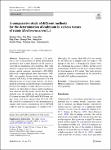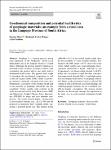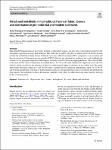Browsing by Subject ICP-MS
Showing results [1 - 3] / 3
Remediation of cadmium (Cd) pollution is one of the priorities of global environmental governance and accurate detection of Cd content is a key link in remediation of Cd pollution. This study aimed to compare three methods (inductively coupled plasma optical emission spectrometry (ICP-OES), inductively coupled plasma mass spectrometry (ICP-MS), and graphite furnace-atomic absorption spectrometry (GF-AAS)) for the determination of Cd with different tissues of various ramie varieties, and distinguish the advantage and disadvantage of each method. In total, 162 samples of ramie (Boehmeria nivea L.), which is an ideal plant for heavy metal remediation, were detected and the results showed... |
Geophagy is a common practice among rural population of the Fetakgomo Tubatse Local Municipality area in the Limpopo Province of South Africa. Although, the practice might be beneficial to the health of the consumers, its negative effects could overshadow the positive effects and might lead to detrimental health issues. The present work sought to investigate the geochemical composition as well as pH and organic matter (OM) content of geophagic materials commonly consumed in the study area. Furthermore, assessment of the potential health risk of the materials on geophagic individuals was also considered. Twelve samples were collected in the study area and analysed by X-ray Fluorescence... |
High-altitude Pyrenean lakes are ecosystems far from local pollution sources, and thus they are particularly sensitive to the atmospheric deposition of metals and metalloids. This study aims to quantify the effect of human activity in 18 lakes located in both side of the France–Spain frontier. Sediment cores were collected in summer 2013, sampled at a 1cm resolution and the concentration of 24 elements was measured by ICP-MS. Statistic and chemometric analysis of the results highlights the influence of the geographical position and lithogenic features of each lake basin on trapping pollutants. More than the 80% of the lakes showed values of enrichment factor (EF) above 2 for at least ... |



